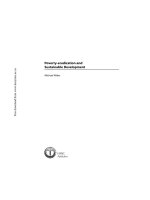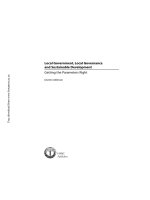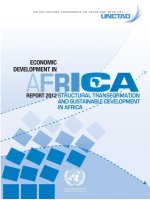English for Economic Topic Globalization and sustainable development
Bạn đang xem bản rút gọn của tài liệu. Xem và tải ngay bản đầy đủ của tài liệu tại đây (2.22 MB, 31 trang )
CAN THO UNIVERSITY
COLLEGE OF ECONOMICS
GLOBALIZATION
and
SUSTAINABLE DEVELOPMENT
Teacher: Trần Thy Linh Giang
Group 5
1. Nguyễn Thị Kim Thoa
2. Đặng Thị Huyền Trân
3. Đặng Thanh Vân
4. Trần Yến Linh
5. Danh Thị Kim Thoa
6. Võ Yến Nhi
B1401784
B1401795
B1401799
B1403111
B1403255
B1507646
CONTENT
Introduction
• Globalization is a related phenomenon with an
increase in the number and intensity of mechanisms,
processes and activities that promote increased
interdependence among nations in the world as well
as the Economic and political integration at the
global level.
• Sustainable development is a development aimed at
satisfying the present needs of human without
affects meeting demand of the needs of future
generations.
Manifestation of the globalization
• The rapid development of international trade relations.
• The development and impact of transnational
companies.
• The merger and consolidation of companies into large
corporations.
• The birth of international and regional economic and
financial linkages: International Monetary Fund
(IMF), World Bank (WB), World Trade Organization
(WTO), European Union Europe (EU), the
Association of Southeast Asian Nations ASEAN).
What topics do you like?
Technology
Transfer
Labour
Markets
Raw Material
Environmental
Concerns
Raw Materials
The raw materials are the basic materials from which goods and
products are made. Usually, raw materials are natural resources.
Positive impacts
• Economic growth
• The quality of life has improved
• Creating more jobs and improving
infrastructure
Negative impacts
• The economy is more vulnerable to the fluctuation of the
world economic situation.
• The resulting mining pollution includes toxic
contamination of the natural water supply for communities.
• The poverty rate is high, the environment is polluted and
the infrastructure is destroyed. Ex: africa, a country have
many gold mine.
• The lack of transparency and accountability in industry
governance has resulted in the low economic efficiency of
the sector, serious social and environmental impacts, and
unequal benefit sharing.
Solutions
• The exploration activities have to boost to
define potential reserves of minerals so that
the Government could have proper planning
for each type of mineral.
• It’s necessary to have a legally binding
framework for companies to force them to be
transparent about their supply chain.
Technology tranfer
Information technology:
telephone, fax and internet.
Reduce production costs,
improve business efficiency,
facilitate exchanges between
countries quickly.
Example: nowadays, there are many
active websites like Amazon,
Ebay, Alibaba,.... These are
online selling websites and can
be sold anywhere in the world.
Technology tranfer
Creates new materials with
better materials, lower costs as a
substitute for traditional
materials
Example:
• Special plastics, composite
materials, fiber optics,…
replacement of conventional
materials
• Energies like wind energy, solar
energy is used instead of oil.
Positive impacts
Technology revolution speeds up the process of
globalization faster.
Technological achievements have been transferred and
widely applied, allowing developing countries to achieve
scientific and technical achievements.
Technology development with the introduction of robots,
that have high productivity Increasing production
efficiency.
Negative impacts
• The risk of economic lag in developing countries,
widening the development gap between nations, increasing
social injustice.
• The birth of the robot leads to
the risk of unemployment for
workers.
Solution
In order to limit these negative consequences, each
country needs to have a strategy for the development
of science and technology in accordance with their
national conditions and circumstances.
Environmental Concerns
• Firstly, I want to remind us of resources such
as oil, copper and coal. These are limited.
While exploiting is unlimited. Moreover,
substitute can not found.
• Over-using them lead to the rapid exhaustion
of the natural resources.
Resoures
Laws
• Secondly, I consider laws. Nowadays, some
multinational companies ignore them.
Pollution
• Finally, we consider pollution.
Solution
• It has made so many changes in our lives that
reversing it is not possible at all.
Labour market
Labour Markets
Definition
• A labour market is the place where workers and
employees interact with each other. In the labour
market, employers compete to hire the best, and the
workers compete for the best. satisfying job.
Migration
• Two main groups of workers involved in the labour
migration process: (i) highly skilled workers and (ii)
unskilled workers.
• Workers with high qualifications move from developed
countries to less developed countries.
• By contrast, unskilled workers move from less developed
countries to the more developed countries.
• Workers going overseas to work for economic reasons
(labour exchange)
Positive impacts
• Workers have more choices in their work
• The export of labor to countries such as Japan, Korea,
Taiwan,...
• Contribute to improving and enhancing the life of the
society.
Labor export to the market has become an important
driving force for the development of the employment
system, enhancing the quality of human resources.
Negative impacts
• The labour movement according to market
rules is often not match the socio-economic
development plan.
• Too much labor has a university degree in
urban centers, while this kind of labor is very
lacking in difficult economic areas.
Solutions
• Human resources training for the development of
high technology fields.
• Training human resources for economic restructuring
and labor reform in rural areas
• Human resources training for labor export
• Improving policies to promote human resource
development
• Improving labor policy
• Policy to solve social problems of labor









